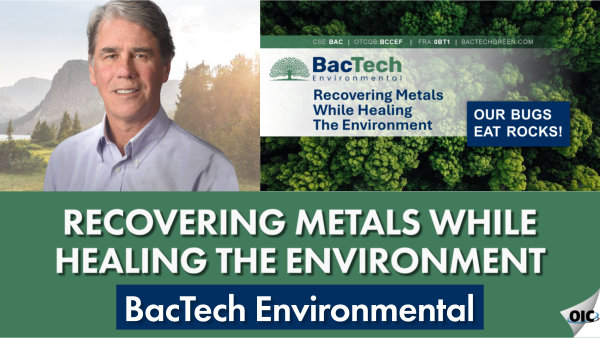In an era where environmental responsibility is reshaping global industries, BacTech Environmental (CSE: BAC | OTC: BCCEF) stands out as a transformative force. The company’s pioneering bioleaching technology offers a powerful solution to one of mining’s most persistent problems: toxic tailings. By harnessing naturally occurring bacteria to safely neutralize arsenic and extract valuable metals, BacTech is unlocking both environmental and economic value.
President and CEO Ross Orr is a seasoned executive who’s been guiding BacTech since the 1990s. Under his leadership, the company has evolved from licensing its technology to mining firms into a fully integrated clean-tech operator. Its flagship project in Ecuador—now shovel-ready—marks a major milestone: BacTech’s first owned and operated facility built to treat arsenic-rich gold concentrates and abandoned tailings.
The Bioleaching Advantage
At its core, BacTech’s process uses specialized bacteria to break down sulfide minerals like arsenopyrite, which are notorious for containing both gold and arsenic. Left untreated, these minerals leach sulfuric acid into the environment—poisoning rivers and communities. But in BacTech’s sealed system, the bacteria perform the same breakdown in just six days under controlled conditions. The result: gold and silver are safely separated and recovered, while arsenic is neutralized into a stable, EPA-compliant form.
Importantly, this isn’t theoretical. BacTech has already built and operated three plants—two in Australia and one in China—proving the commercial viability of its approach. The Ecuador project is its next evolution: a company-owned facility expected to generate strong margins while setting a new standard for environmental performance.
Ecuador: Shovel-Ready and Highly Profitable
The Ecuador facility, located near the port city of Machala, targets artisanal gold producers who generate arsenic-laced concentrates. These small miners currently sell to Chinese buyers at deep discounts—often just 45 to 50 cents on the dollar—due to the toxic nature of their output. BacTech offers a better solution: process the same material using clean, closed-loop technology and pay miners a fair price while recovering gold more efficiently.
Pilot testing at a Perth-based facility demonstrated gold recoveries of 96.2% and complete arsenic stabilization. A subsequent bankable feasibility study projected a capital cost of $17 million USD, with the first year’s profit expected to match that figure—essentially paying back the entire investment within 12 months. Operating costs are just $212 per tonne, and a 12-year tax holiday secured via an international protection agreement (IPA) with the Ecuadorian government adds to the appeal.
BacTech’s environmental credibility was further validated by Moody’s, which rated its proposed $20 million green bond offering as “very good”—an important endorsement for ESG-focused investors.
Modular Growth and Global Potential
The Ecuador project is designed in two phases. The first will process 50 tonnes per day, with a second phase adding 200 tonnes to create a regional processing hub. Material could be sourced from across Ecuador, as well as neighboring Peru and Colombia. The IPA allows for up to $75 million in total investment, providing room for expansion.
BacTech has also identified future plant locations, including two more in Ecuador, two in Peru, and one in Colombia. If built, these facilities could collectively produce 300,000 to 400,000 ounces of gold annually—all while eliminating a major environmental hazard.
Innovation in Sudbury
Beyond South America, BacTech is also applying its bioleaching expertise to legacy mining issues in Canada. In partnership with Vale, Glencore, and government researchers, the company is exploring ways to treat pyrrhotite—an unstable sulfide mineral stockpiled in massive quantities around Sudbury. A pilot plant, operated by Dr. Nadia Mykytczuk in collaboration with Canmet and the University of Toronto, is targeting ways to convert this waste into usable products like fertilizer, sulfuric acid, and iron feedstock.
Though early-stage, this R&D initiative could unlock a new category of zero-waste mineral recycling—repositioning BacTech not just as a gold processor, but as a global environmental technology platform.
A Market Disconnect—and an Opportunity
Despite the clear path to revenue, BacTech remains deeply undervalued. With a market cap of just CAD $11 million and an NPV of USD $100 million for the Ecuador project alone, the disconnect is striking. Management believes this stems from investor unfamiliarity with the bioleaching process and a “show me” attitude toward unbuilt plants.
But with permitting complete, financing underway, and construction timelines estimated at 12–13 months, BacTech is on the verge of converting technology into recurring revenue. Once operational, the first facility could serve as a model for rapid replication—backed by environmental credentials, government support, and proven economics.
Final Thoughts
As the world grapples with the environmental legacy of mining, BacTech Environmental is offering a way forward. Its unique approach not only cleans up toxic waste but does so profitably—turning abandoned tailings into gold and goodwill.
Investors seeking exposure to ESG-driven innovation in mining, backed by real technology and near-term cash flow, may want to take a closer look. Because at BacTech, as Ross Orr puts it, “Our bugs eat rocks”—and that simple idea could transform an industry.
WATCH IT HERE: BacTech Environmental: Turning Toxic Waste into Clean Profits with Bioleaching Innovation
CSE: BAC | US-OTC: BCCEF | FSE: 0BT1
For more information, contact:
Ross Orr, President and CEO
T: (416) 813-0303 x222
E: info@bactechgreen.com
W: bactechgreen.com



